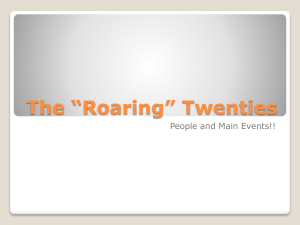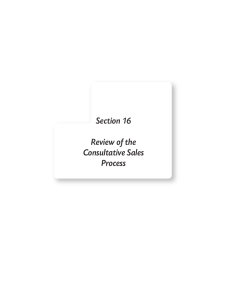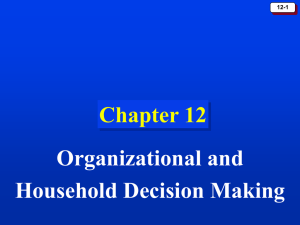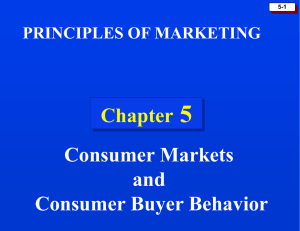Chapter 1
advertisement
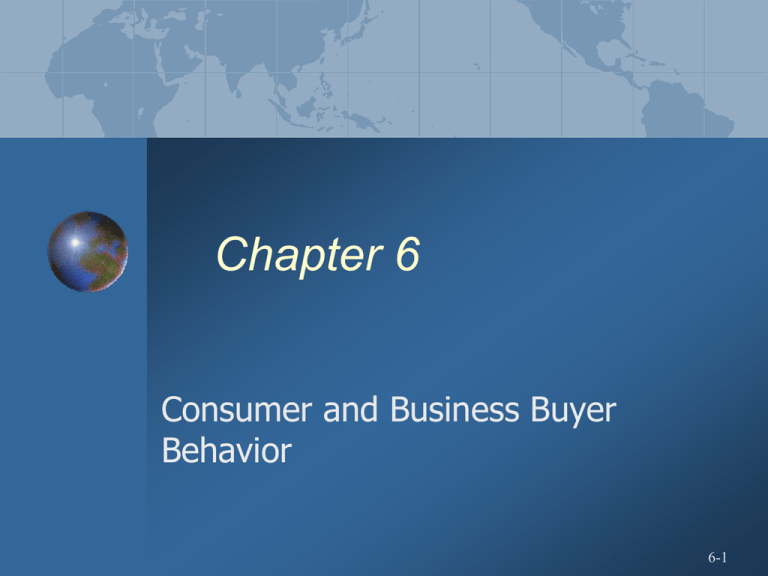
Chapter 6 Consumer and Business Buyer Behavior 6-1 Road Map: Previewing the Concepts Understand the consumer market and the major factors that influence consumer buyer behavior. Identify and discuss the stages in the buyer decision process. Describe the adoption and diffusion process for new products. Define the business market and identify the major factors that influence business buyer behavior. List and define the steps in the business buying decision process. 6-2 Consumer Buying Behavior Consumer Buying Behavior refers to the buying behavior of final consumers individuals & households - who buy goods and services for personal consumption. These final consumers make up the consumer market. The central question for marketers is: “How do consumers respond to various marketing efforts the company might use?” 6-3 Model of Buyer Behavior (Fig. 6-1) 6-4 Factors Influencing Consumer Behavior (Fig. 6-2) 6-5 Factors Affecting Consumer Behavior: Culture Culture is the Most Basic Cause of a Person's Wants and Behavior. Subculture • Groups of people with shared value systems based on common life experiences. • Hispanic Consumers • African American Consumers • Asian American Consumers • Mature Consumers 6-6 Factors Affecting Consumer Behavior: Culture Social Class • Society’s relatively permanent & ordered divisions whose members share similar values, interests, and behaviors. • Measured by a Combination of: Occupation, Income, Education, Wealth and Other Variables. 6-7 Factors Affecting Consumer Behavior: Social Groups Membership, Reference, or Aspirational Family Most Important Consumer Buying Organization Roles and Status 6-8 Factors Affecting Consumer Behavior: Personal Personal Influences Age and Life Cycle Stage Occupation Economic Situation Personality & Self-Concept Lifestyle Identification Activities Interests Opinions 6-9 Jeep Ad shows how the lifestyle concept (a person’s pattern of living) can help the marketer understand consumer values and how they affect buying behavior. Ad targets people who want to “leave the civilized world behind”. 6-10 Factors Affecting Consumer Behavior: Psychological Motivation Beliefs and Attitudes Psychological Factors Affecting Buyers Choices Perception Learning 6-11 Maslow’s Hierarchy of Needs (Fig. 6-3) 6-12 Buyer Decision Process (Fig. 6-4) 6-13 Buyer Decision Process Step 1. Need Recognition Internal Stimuli – Hunger Buyer Recognizes a Problem or a Need Arising From: External Stimuli- Friends 6-14 The Buyer Decision Process Step 2. Information Search Personal Sources Commercial Sources Public Sources Experiential Sources •Family, friends, neighbors •Most effective source of information •Advertising, salespeople •Receives the most information from these sources •Mass Media •Consumer-rating groups •Handling the product •Examining the product •Using the product 6-15 The Buyer Decision Process Step 4. Evaluation of Alternatives Consumer May Use Careful Calculations & Logical Thinking Consumers May Buy on Impulse and Rely on Intuition Consumers May Make Buying Decisions on Their Own Consumers May Make Buying Decisions Only After Consulting Others Marketers Must Study Buyers to Find Out How They Evaluate Brand Alternatives 6-16 The Buyer Decision Process Step 5. Purchase Decision Purchase Intention Desire to buy the most preferred brand Attitudes of Others Unexpected Situational Factors Purchase Decision 6-17 The Buyer Decision Process Step 6. Postpurchase Behavior Consumer’s Expectations of Product’s Performance Product’s Perceived Performance Cognitive Dissonance Satisfied Customer! Dissatisfied Customer 6-18 Pair with the student on your right. Using the information found in Figure 6-4, trace a recent purchase each of you have made. Be sure to examine each of the five stages of the buyer decision process and detail your experiences in each stage. What could the seller have done to make your buying experience better? Did you experience any cognitive dissonance? Explain. 6-19 Stages in the Adoption Process Awareness: Consumer becomes aware of the new product, but lacks information about it. Interest: Consumer seeks information about new product. Evaluation: Consumer considers whether trying the new product makes sense. Trial: Consumer tries new product on a small scale to improve his or her estimate of its value. Adoption: Consumer decides to make full and regular use of the new product. 6-20 Adopter Categories (Fig. 6-5) 6-21 Influence of Product Characteristics on Rate of Adoption Communicability Relative Advantage Can results be easily observed or described to others? Is the innovation superior to existing products? Compatibility Divisibility Can the innovation be used on a limited basis? Complexity Does the innovation fit the values and experience of the target market? Is the innovation difficult to understand or use? 6-22 Characteristics of Business Markets Market Structure and Demand Contain far fewer, but larger buyers, Customers are more geographically concentrated, Business demand is derived from final consumer demand. Nature of the Buying Unit Business purchases involve more buyers. Business buying involves a more professional purchasing effort. 6-23 Characteristics of Business Markets Types of Decisions and the Business buyers usually face more complex buying decisions. Decision Process Business buying process is more formalized. Buyers and sellers are more dependent on each other. 6-24 Model of Business Buyer Behavior (Fig. 6-6) 6-25 Major Types of Buying Situations Involved Decision Making New Task Buying Modified Rebuy Straight Rebuy 6-26 Identify which of the major types of business buying situations is represented by the following: Chrysler’s purchase of computers that go in cars and adjust engine performance to changing driving conditions. 6-27 Participants in the Business Buying Process Decision-making unit of a buying organization is called its buying center. Not a fixed and formally identified unit. Will vary for different products and buying situations. Major challenge for the marketer to find out: Who is part of the decision? What decisions do they influence? What is their relative degree of influence? What evaluative criteria does each decision participant 6-28 use? Major Influences on Business Buyer Behavior (Fig. 6-7) 6-29 The Business Buying Process (Fig. 6-8) 6-30 Business Buying on the Internet Business buyers may purchase electronically by: Electronic data interchange links (EDI) The Internet E-procurement yields benefits: Eliminates paperwork, Reduces time between order & delivery. E-procurement has problems: Eliminates some jobs, Can erode customer-supplier relationships, Can create security disasters. 6-31 Road Map: Reviewing the Concepts Understand the consumer market and the major factors that influence consumer buyer behavior. Identify and discuss the stages in the buyer decision process. Describe the adoption and diffusion process for new products. Define the business market and identify the major factors that influence business buyer behavior. List and define the steps in the business buying decision process. 6-32
